Autopista / autovía , Carretera Mayor , Carretera Menor , Calle Principal , Calle , Vía de Estacionamiento y Camino Privado
Guía de tipos de Vía en Rotondas
| Descripción
|
Imagen
|
| Una Calle Principal y una Calle se cruzan en una rotonda, así que tenemos dos segmentos de tipo Calle principal y dos de tipo Calle conectados. Rotonda como Calle Principal
2 Calle Principal + 2 Calle = Calle Principal
|
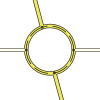
|
| Una Calle Principal y tres segmentos tipo Calle coinciden en una rotonda. Rotonda como Calle.
1 Calle Principal + 3 Calle = Calle
|
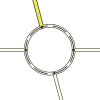
|
| Tres segmentos Calle Principal y uno tipo Calle coinciden en una rotonda. Rotonda como Calle principal.
3 Calle Principal + 1 Calle = Calle Principal
|
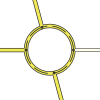
|
| Una Carretera Mayor y una Carretera Menor se cruzan, por lo que tenemos dos segmentos de cada tipo. Rotonda como Carretera Mayor.
2 Carretera Mayor + 2 Carretera Menor = Carretera Mayor
|
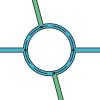
|
| Tres segmentos Carretera Mayor y uno tipo Carretera Menor coinciden en una rotonda. Rotonda como Carretera Mayor.
3 Carretera Mayor + 1 Carretera Menor = Carretera Mayor
|
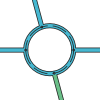
|
| Un segmento de tipo Carretera Mayor, dos de tipo Calle Principal y uno de tipo Calle. (Se puede pensar que la Carretera Mayor empieza o acaba en la rotonda.) Rotonda como Calle Principal
1 Carretera Mayor + 2 Calle Principal + 1 Calle = Calle Principal
|

|
| Una Carretera Mayor, una Calle Principal y dos segmentos tipo Calle coinciden en una rotonda. Rotonda como calle principal.
1 Carretera Mayor + 1 Calle Principal + 2 Calle = Calle Principal
|
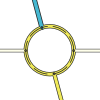
|
| Una Carretera Mayor, una Carretera Menor y dos Calles Principales coinciden en una rotonda. Si usamos la Calle Principal para la rotonda, las rutas se verán penalizadas al pasar de la Carretera Menor a la Carretera Mayor. Rotonda como Carretera Menor.
1 Carretera Mayor + 1 Carretera Menor + 2 Calle Principal = Carretera Menor
|
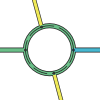
|
| Same as above, except the Major Highway and Minor Highway are divided roadways. (Recall that a divided roadway is treated as one "segment" for this rule.)
1 Carretera Mayor + 1 Carretera Menor + 2 Calle Principal = Carretera Menor
|
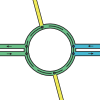
|
| A Ramp (connected to a Major Highway), a Minor Highway, and two Primary Street segments meet. (Recall that the type connected to the ramp is used in the analysis. Effectively, it's the same as the previous two examples.)
1 Carretera Mayor + 1 Carretera Menor + 2 Calle Principal = Carretera Menor
|
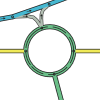
|
| Only Ramp segments are connected to a Roundabout. If every segment connected is a Ramp, so is the Roundabout. (When only Ramps connect to a Roundabout, none of the connected road types are considered.)
Todo Rampas = Rampa
|
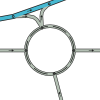
|
Guía de tipos de Vía en Rotondas
| Descripción
|
(Tipo mayor)
(Tipo Rotonda)
|
Imagen
|
| Una Calle Principal y una Calle se cruzan en una rotonda, así que tenemos dos segmentos de tipo Calle principal y dos de tipo Calle conectados. Rotonda como Calle Principal
2 Calle Principal + 2 Calle = Calle Principal
|
Calle Principal
|

|
| Una Calle Principal y tres segmentos tipo Calle coinciden en una rotonda. Rotonda como Calle.
1 Calle Principal + 3 Calle = Calle
|
Calle
|

|
| Tres segmentos Calle Principal y uno tipo Calle coinciden en una rotonda. Rotonda como Calle principal.
3 Calle Principal + 1 Calle = Calle Principal
|
Primary Street
Primary Street
|

|
| Una Carretera Mayor y una Carretera Menor se cruzan, por lo que tenemos dos segmentos de cada tipo. Rotonda como Carretera Mayor.
2 Carretera Mayor + 2 Carretera Menor = Carretera Mayor
|
Major Highway
Major Highway
|

|
| Tres segmentos Carretera Mayor y uno tipo Carretera Menor coinciden en una rotonda. Rotonda como Carretera Mayor.
3 Carretera Mayor + 1 Carretera Menor = Carretera Mayor
|
Major Highway
Major Highway
|

|
| Un segmento de tipo Carretera Mayor, dos de tipo Calle Principal y uno de tipo Calle. (Se puede pensar que la Carretera Mayor empieza o acaba en la rotonda.) Rotonda como Calle Principal
1 Carretera Mayor + 2 Calle Principal + 1 Calle = Calle Principal
|
Major Highway
Primary Street
|

|
| Una Carretera Mayor, una Calle Principal y dos segmentos tipo Calle coinciden en una rotonda. Rotonda como calle principal.
1 Carretera Mayor + 1 Calle Principal + 2 Calle = Calle Principal
|
Major Highway
Primary Street
|

|
| Una Carretera Mayor, una Carretera Menor y dos Calles Principales coinciden en una rotonda. Si usamos la Calle Principal para la rotonda, las rutas se verán penalizadas al pasar de la Carretera Menor a la Carretera Mayor. Rotonda como Carretera Menor.
1 Carretera Mayor + 1 Carretera Menor + 2 Calle Principal = Carretera Menor
|
Major Highway
Minor Highway
|

|
| Same as above, except the Major Highway and Minor Highway are divided roadways. (Recall that a divided roadway is treated as one "segment" for this rule.)
1 Carretera Mayor + 1 Carretera Menor + 2 Calle Principal = Carretera Menor
|
Major Highway
Minor Highway
|

|
| A Ramp (connected to a Major Highway), a Minor Highway, and two Primary Street segments meet. (Recall that the type connected to the ramp is used in the analysis. Effectively, it's the same as the previous two examples.)
1 Carretera Mayor + 1 Carretera Menor + 2 Calle Principal = Carretera Menor
|
Major Highway
Minor Highway
|

|
| Only Ramp segments are connected to a Roundabout. If every segment connected is a Ramp, so is the Roundabout. (When only Ramps connect to a Roundabout, none of the connected road types are considered.)
Todo Rampas = Rampa
|
Ramp
|

|
Guía de tipos de Vía en Rotondas
| Descripción
|
(Tipo mayor)
(Tipo Rotonda)
|
Imagen
|
| Una Calle Principal y una Calle se cruzan en una rotonda, así que tenemos dos segmentos de tipo Calle principal y dos de tipo Calle conectados.
2 Calle Principal + 2 Calle
|
Calle Principal
|

|
| Una Calle Principal y tres segmentos tipo Calle coinciden en una rotonda.
1 Calle Principal + 3 Calle = Calle
|
Calle
|

|
| Three Primary Street segments and one Street segment meet.
|
Primary Street
Primary Street
|

|
| A Major Highway and a Minor Highway cross so we have two segments of each type.
|
Major Highway
Major Highway
|

|
| Three Major Highway segments and one Minor Highway segment meet.
|
Major Highway
Major Highway
|

|
| A Major Highway, two Primary Streets, and one Street segment meet. (The Major Highway can be thought to start/end at the Roundabout.)
|
Major Highway
Primary Street
|

|
| A Major Highway, a Primary Street, and two Street segments meet at a Roundabout.
|
Major Highway
Primary Street
|

|
| A Major Highway, a Minor Highway, and two Primary Street segments meet. (If we used Primary Street, routing would be penalized going from the Minor Highway to the Major Highway.)
|
Major Highway
Minor Highway
|

|
| Same as above, except the Major Highway and Minor Highway are divided roadways. (Recall that a divided roadway is treated as one "segment" for this rule.)
|
Major Highway
Minor Highway
|

|
| A Ramp (connected to a Major Highway), a Minor Highway, and two Primary Street segments meet. (Recall that the type connected to the ramp is used in the analysis. Effectively, it's the same as the previous two examples.)
|
Major Highway
Minor Highway
|

|
| Only Ramp segments are connected to a Roundabout. If every segment connected is a Ramp, so is the Roundabout. (When only Ramps connect to a Roundabout, none of the connected road types are considered.)
Todo Rampas = Rampa
|
Ramp
|

|